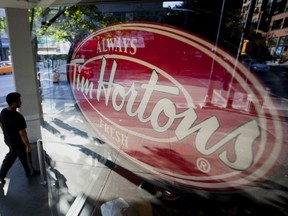Fast-food chain has increased menu prices ‘when and where appropriate’

Article content
Price hikes at Tim Hortons are helping drive double-digit sales growth at the coffee chain, as parent company Restaurant Brands International Inc. tries to stay ahead of rising food and labour costs, according to an earnings update on Thursday.
Advertisement 2
Article content
RBI chief executive José Cil told analysts that inflationary pressures in the supply chain, along with rising interest rates, have pushed the fast-food chain to increase menu prices “when and where appropriate.”
Article content
Sales at Tim Hortons hit US$1.9 billion in the quarter ended Sept. 30, about nine per cent better than the same period a year ago, helping drive RBI’s profits up to US$436 million, or 96 cents U.S. per share, well above analyst forecasts of 80 cents U.S.
Tim Hortons’ same-store sales — a common metric in retail to gauge year-over-year performance by ignoring results from recently opened or closed locations — grew 11.1 per cent in Canada. The results were “aided by strategic price increases,” Cil said on the call.
Advertisement 3
Article content
Menu prices have been rising faster at fast-food restaurants than other parts of the restaurant industry in Canada. Fast-food prices rose by 7.7 per cent in September compared to the previous year, while the overall food service industry’s inflation rate is 7.5 per cent, according to Statistics Canada. However, both are well behind the 11.4-per-cent inflation rate at grocery stores.
“Any price changes that our guests have seen at Tim Hortons are in line with our top competitors in the restaurant industry,” RBI chief corporate officer Duncan Fulton said. “We carefully look in the mirror whenever we adjust prices, to make sure that we’re competitive in the region that you live in, and we continue to give you great value for money.”
Advertisement 4
Article content

RBI wouldn’t say how much the price increases contributed to sales growth. The chain also highlighted other factors behind its recent success, including Tim Hortons’ attempts to court diners at lunch and dinner, two segments, known as “day parts” in the fast-food business, that haven’t been the chain’s strong suit in the past.
“These results were driven by continued strength from our core offerings and strong calendar initiatives to extend Tim Hortons into high-growth day parts and products, aided by strategic price increases,” Cil told analysts.
The chain, with more than 5,400 locations worldwide, limped through the pandemic, mostly because morning commuters — a key customer base for coffee shops — all but disappeared after public-health restrictions forced most office workers to work from home.
Advertisement 5
Article content
Any price changes that our guests have seen at Tim Hortons are in line with our top competitors
Duncan Fulton
Cil said the return to downtown office buildings has been “uneven” and sales in hot beverages haven’t rebounded to pre-pandemic levels.
But Tim Hortons isn’t waiting for commuters to come back. Instead, the chain has been chasing lunch and dinner traffic with a series of new menu items, including a line of “loaded” rice bowls. It also experimented with pizza this summer.
That sort of experimentation has proven to be a dangerous game for Tim Hortons in the past. In early 2020, the company announced it was going “back to basics,” refocusing on coffee and doughnuts after a failed string of menu launches — including poutine and a now-infamous Beyond Meat burger — complicated its simple kitchens and aggravated franchisees.
Advertisement 6
Article content
-

‘Sweet deal’ for Tims? Coffee-and-doughnut privacy breach settlement a marketing win, says expert
-

‘We also must win in espresso’: Tim Hortons charts new phase in multi-year turnaround
But it’s working this time around, Cil said. The menu changes helped push lunchtime sales up 15 per cent over pre-pandemic levels. Ten per cent of all transactions at Tims now include an afternoon food item, up from seven per cent in 2019, he said.
Sales at the chain are now well above pre-pandemic levels — beating the third quarter of 2019 by about US$171 million — signalling that Tim Hortons has fully emerged from its pandemic funk, even if morning coffee drinkers haven’t.
Profits at RBI, which also owns Burger King, Popeyes Louisiana Kitchen and Firehouse Subs, rose to US$436 million on an adjusted basis, from US$353 million in the third quarter of 2021. Earnings per share of 96 cents U.S. exceeded analyst forecasts of 80 cents U.S., according to the Wall Street Journal.
Advertisement 7
Article content
RBI said the profit growth was partly driven by Tim Hortons’ higher earnings before interest, taxes, depreciation and amortization (EBITDA) of US$305 million — the highest derived from any of RBI’s brands — compared to US$278 million the previous year.
The better-than-expected profits at were “driven by Tims’ momentum,” Christopher Carril, an analyst at RBC Capital Markets LLC, said in a note to clients on Thursday.
“Tim Hortons continues to drive strong performance in Canada … providing further evidence that the brand’s ‘Back to Basics’ plan is working,” he said.
• Email: jedmiston@nationalpost.com | Twitter: jakeedmiston
